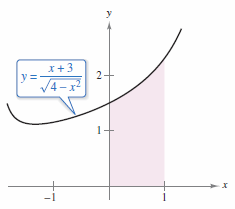Calculus II 08.01 Basic Integration Rules
| Previous | Calculus II 07 Integration Applications |
| Next | Calculus II 08.02 Integration by Parts |
Contents
- 1 8.1 Basic Integration Rules
- 1.1 Fitting Integrands to Basic Integration Rules
- 1.1.1 Example 8.1.1 Comparing Three Similar Integrals
- 1.1.2 Example 8.1.2 Solving a Single Integral using Two Basic Rules
- 1.1.3 Example 8.1.3 A Substitution using \(a^{2}-u^{2}\)
- 1.1.4 Example 8.1.4 The Log Rule in Disguise
- 1.1.5 Example 8.1.5 The Power Rule in Disguise
- 1.1.6 Example 8.1.6 Using Trigonometric Identities
- 1.1 Fitting Integrands to Basic Integration Rules
- 2 Internal Links
8.1 Basic Integration Rules
- Review procedures for fitting an integrand to one of the basic integration rules.
Fitting Integrands to Basic Integration Rules
A major step in solving any integration problem is recognizing which basic integration rule to use. See Integration Rules
Example 8.1.1 Comparing Three Similar Integrals
Find each integral.
- $$\textbf{a. } \int \frac{4}{x^{2}+9}dx $$
- $$\textbf{b. } \int \frac{4x}{x^{2}+9}dx $$
- $$\textbf{c. } \int \frac{4x^{2}}{x^{2}+9}dx $$
Solution
a. Use the Arctangent Rule and let \(u=x\) and \(a=3\).
| $$ \int \frac{4}{x^{2}+9}dx $$ | $$ = 4 \int \frac{1}{x^{2}+3^{2}}dx $$ | Constant Multiple Rule |
| $$ = 4 \left( \frac{1}{3} \arctan \frac{x}{3} \right) + C \:\:\:\: $$ | Arctangent Rule | |
| $$ = \frac{4}{3} \arctan \frac{x}{3} + C $$ | Simplify. |
b. The Arctangent Rule does not apply because the numerator contains the variable \(x\). Consider the Log Rule and let \(u=x^{2}+9\). Then \(du=2x\:dx\), producing
| $$ \int \frac{4x}{x^{2}+9}dx $$ | $$ = 2 \int \frac{2x}{x^{2}+9}dx $$ | Constant Multiple Rule |
| $$ = 2 \int \frac{du}{u} $$ | Substitution: \(u=x^{2}+9\) | |
| $$ = 2\: \ln \left |u \right | + C $$ | Log Rule | |
| $$ = 2\:\ln(x^{2}+9) + C \:\:\:\: $$ | Substitution: \(u=x^{2}+9\) |
c. Because the numerator's degree equals the denominator's, you should first use long division to rewrite the improper rational function as a polynomial plus a proper rational function.
| $$\int \frac{4x^{2}}{x^{2}+9}dx $$ | $$ = \int \left( 4 + \frac{-36}{x^{2}+9} \right) dx $$ | Rewrite using long division |
| $$ = \int 4\:dx - 36 \int \frac{1}{x^{2}+9}\:dx $$ | Write as two integrals. | |
| $$ = 4x - 36 \left( \frac{1}{3} \arctan \frac{x}{3} \right) + C \:\:\:\: $$ | Integrate using the Arctangent Rule | |
| $$ = 4x - 12 \arctan \frac{x}{3} + C $$ | Simplify. |
Example 8.1.2 Solving a Single Integral using Two Basic Rules
|
Evaluate
Solution Simplify the integral by breaking it in two. Then apply the Power and Arcsine Rules. See Figure 8.1.1
|
Example 8.1.3 A Substitution using \(a^{2}-u^{2}\)
Some integration rules have expressions with the sum or difference between two squares, \(a^{2}-u^{2}\), \(a^{2}+u^{2}\), and \(u^{2}-a^{2}\).
Find
- $$ \int \frac{x^{2}}{\sqrt{16-x^{6}}}dx .$$
Solution Because the radical in the denominator can be written in the form
- $$ \sqrt{ a^{2}-u^{2} } = \sqrt{4^{2}-(x^{3})^{2}} $$
the substitution \(u=x^{3}\) gives \(du=3x^{2}dx\), and produces the following solution
| $$\int \frac{x^{2}}{\sqrt{16-x^{6}}}dx $$ | $$ = \frac{1}{3} \int \frac{3x^{2}}{\sqrt{16-(x^{3})^{2}}}dx \:\:\:\: $$ | Rewrite the integral. |
| $$= \frac{1}{3} \int \frac{du}{\sqrt{4^{2}-u^{2}}} $$ | Substitution: \(u=x^{3}\) | |
| $$= \frac{1}{3} \arcsin \frac{u}{4} + C $$ | Arcsine Rule | |
| $$= \frac{1}{3} \arcsin \frac{x^{3}}{4} + C $$ | Substitution: \(x^{3}=u\) |
Example 8.1.4 The Log Rule in Disguise
Find how to use the Log Rule to evaluate
- $$ \int \frac{1}{1+e^{x}}dx .$$
Solution The integral does not appear to fit any rule. The quotient form does suggest the Log Rule. If \(u=1+e^{x}\), then \(du=e^{x}\). Adding and subtracting \(e^{x}\) in the numerator produces the required \(du\).
| $$ \int \frac{1}{1+e^{x}}dx $$ | $$ = \int \frac{1+e^{x}-e^{x}}{1+e^{x}}dx $$ | Add and subtract \(e^{x}\) in the numerator. |
| $$= \int \left( \frac{1+e^{x}}{1+e^{x}}-\frac{e^{x}}{1+e^{x}} \right)\:dx \:\:\:\:$$ | Rewrite as two fractions. | |
| $$= \int dx- \int \frac{e^{x}dx}{1+e^{x}} $$ | Rewrite as two integrals. | |
| \(= x-\ln \left( 1+e^{x} \right) + C \) | Integrate. |
Example 8.1.5 The Power Rule in Disguise
Find
- $$ \int (\cot x) \left[ \ln(\sin x) \right]\: dx .$$
Solution Consider the two primary choices for \(u\)
- $$ u=\cot x \text{ or }u=\ln(\sin x) $$
and choose the one that makes the integral easier to solve. The second choice uses the Power Rule. Applying that
- $$u=\ln(\sin x) \text{ and }du=\frac{\cos x}{\sin x}dx=\cot x\:dx $$
This produces
| $$ \int (\cot x) [\ln(\sin x)]dx $$ | $$ = \int u\:du $$ | Substitution: \(u=\ln(\sin x)\) |
| $$ = \frac{u^{2}}{2}+C $$ | Integrate | |
| $$= \frac{1}{2} \left[\ln(\sin x) \right]^{2}+C \:\:\:\:$$ | Rewrite in \(x\) terms. |
Example 8.1.6 Using Trigonometric Identities
Find
- $$ \int \tan^{2}2x\:dx .$$
Solution Note that \(\tan^{2}u\) does not fit a basic integration rule. But \(\sec^{2}u\) is. Using the trigonometric identity \(\tan^{2}u=\sec^{2}-1\) lets \(u=2x\) and \(du=2\:dx\). This produces
| $$ \int \tan^{2}2x\:dx $$ | $$= \frac{1}{2} \int \tan^{2}u\:du $$ | Substitution: \(u=2x\) |
| $$= \frac{1}{2} \int ( \sec^{2}-1)\:du $$ | Trigonometric identity | |
| $$= \frac{1}{2} \int \sec^{2}u\:du - \frac{1}{2} \int \:du \:\:\:\:$$ | Rewrite as two integrals | |
| $$= \frac{1}{2} \tan u - \frac{u}{2} + C $$ | Integrate | |
| $$= \frac{1}{2} \tan 2x - x + C $$ | Substitute: \(2x=u\) |
Internal Links
Parent Article: Calculus II 08 Integration Techniques
